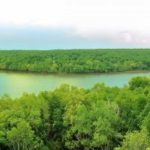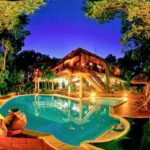Plitvice Lakes National Park is one of the oldest and largest national parks in Croatia. In 1979, Plitvice Lakes National Park was inscribed on the UNESCO World Heritage list, due to its outstanding and picturesque series of tufa lakes, caves, connected by waterfalls.
The national park was founded in 1949 and is in the mountainous karst area of central Croatia, at the border to Bosnia and Herzegovina. The important north-south road that passes through the national park area connects the Croatian inland with the Adriatic coastal region. The protected area extends over 296.85 square kilometers (73,350 acres). About 90% of this area is part of Lika-Senj County, while the remaining 10% is part of Karlovac County.
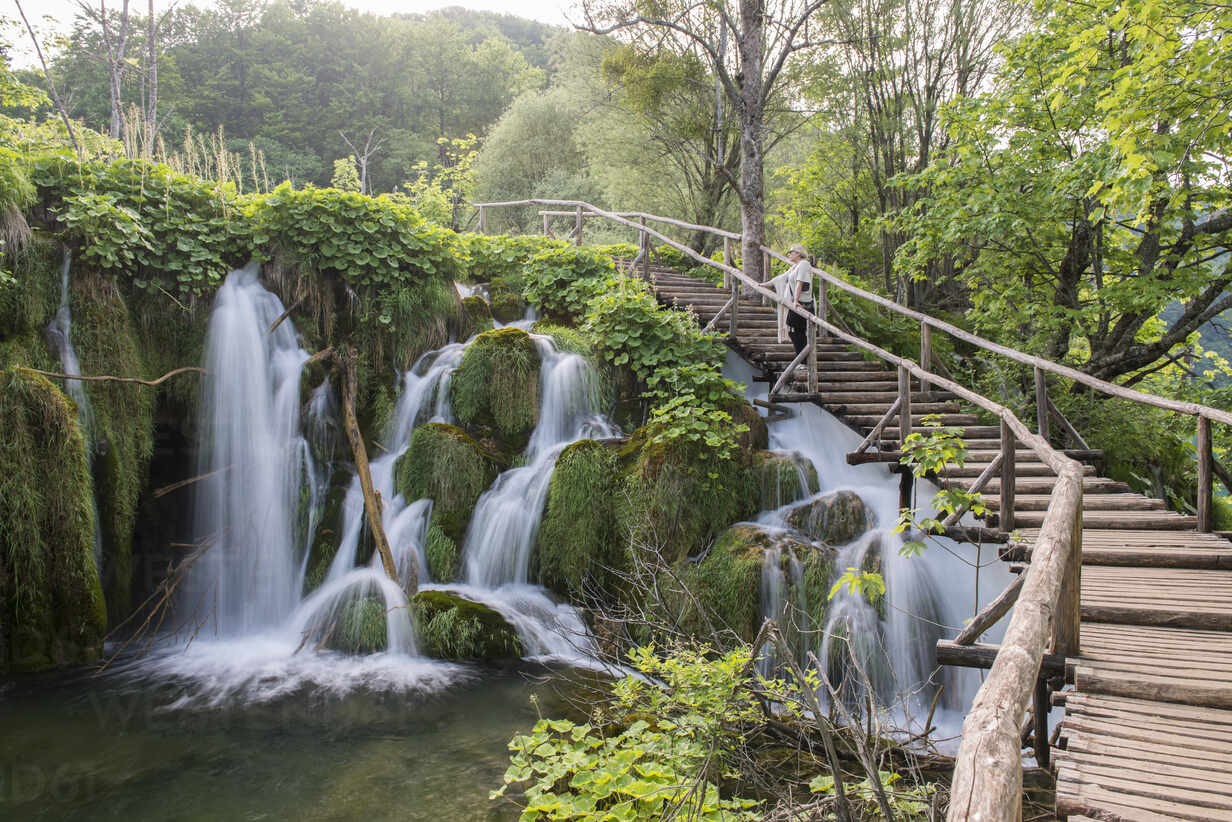 |
| Photo: Westend61 |
Where is Plitvice Lakes National Park?
Plitvice Lakes is located in central Croatia. The closest cities are Zagreb and Zadar. It is possible to visit Plitvice Lakes on a day trip from Zagreb, Zadar, and Split. However, you will spend a lot of time in the car. If you are doing this in the summer months, you will most likely arrive at peak time when the boardwalks are congested with lots of people.
For the best experience, plan to stay overnight near the park so you can have an early start to your day. It’s worth it!
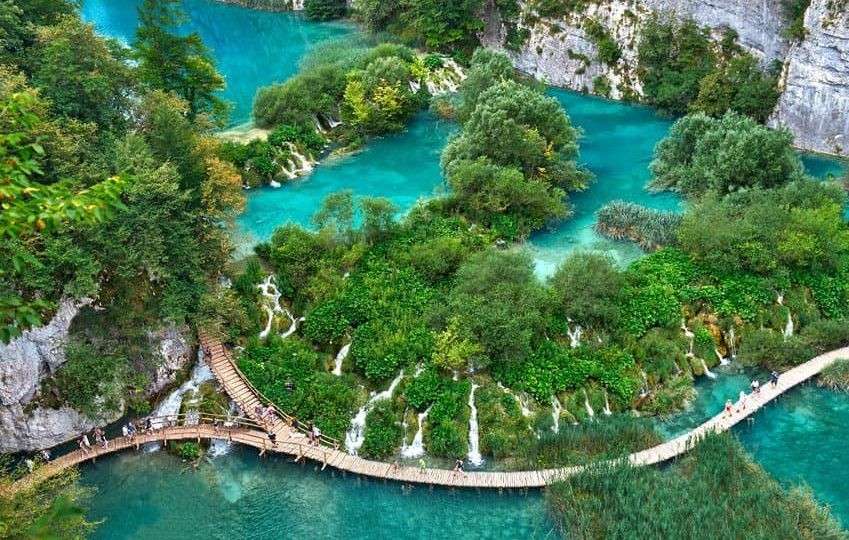 |
| Photo: OnHisOwnTrip |
When was Plitvice Lakes National Park found?
The name Plitvice was first mentioned in a written document in 1777 by Dominik Vukasović, the priest of Otočac. This name was designated due to natural phenomena that have created the lakes. Nature formed shallow basins (Croatian pličina or plitvak, plitko means shallow), which have been filled with water. For centuries, water has changed the limestone and thus the landscape of this area. The emerging travertine barriers decelerated and retained the flowing water. These dams are continuously growing in height.
Some scientists refer to the river Plitvica as the origin of the name. This little river flows into the Plitvice Lakes at the lower and final part of the lakes. A nearby village bears the same name. The water masses of the Plitvice Lakes continue as the Korana river in the northern direction.
The national park became famous during the 1960s and 1970s through several Western film productions of Karl May novels. Many scenes have been shot at the lakes or waterfalls.
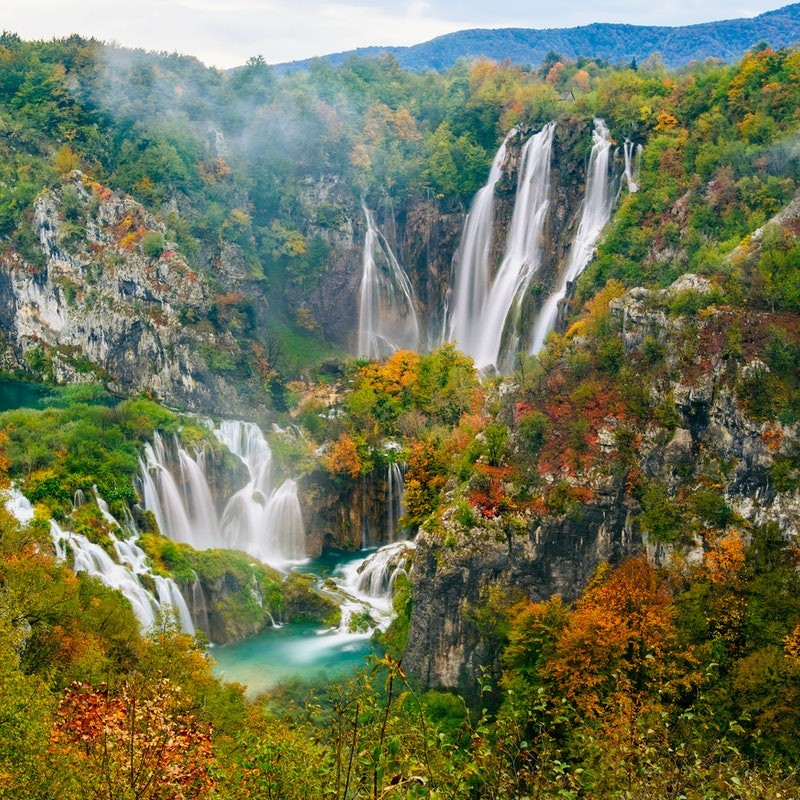 |
| Photo: Tiqets |
The national park is world-famous for its lakes arranged in cascades. Sixteen lakes can be seen from the surface. These lakes are a result of the confluence of several small rivers and subterranean karst rivers. The lakes are all interconnected and follow the water flow. They are separated by natural dams of travertine, which is deposited by the action of moss, algae, and bacteria. The particularly sensitive travertine barriers are the result of an interplay between water, air, and plants. The encrusted plants and bacteria accumulate on top of each other, forming travertine barriers that grow at the rate of about 1 cm (0.4 in) per year.
The 16 lakes are separated into an upper and lower cluster formed by runoff from the mountains, descending from an altitude of 636 to 503 m (2,087 to 1,650 ft) over a distance of some 8 kilometers (5.0 mi), aligned in a south-north direction. The lakes collectively cover an area of about 0.77 square miles, the water exiting from the lowest lake forming the Korana River.
The lakes are renowned for their distinctive colors, ranging from azure to green, grey, or blue. The colors change constantly depending on the number of minerals or organisms in the water and the angle of sunlight.
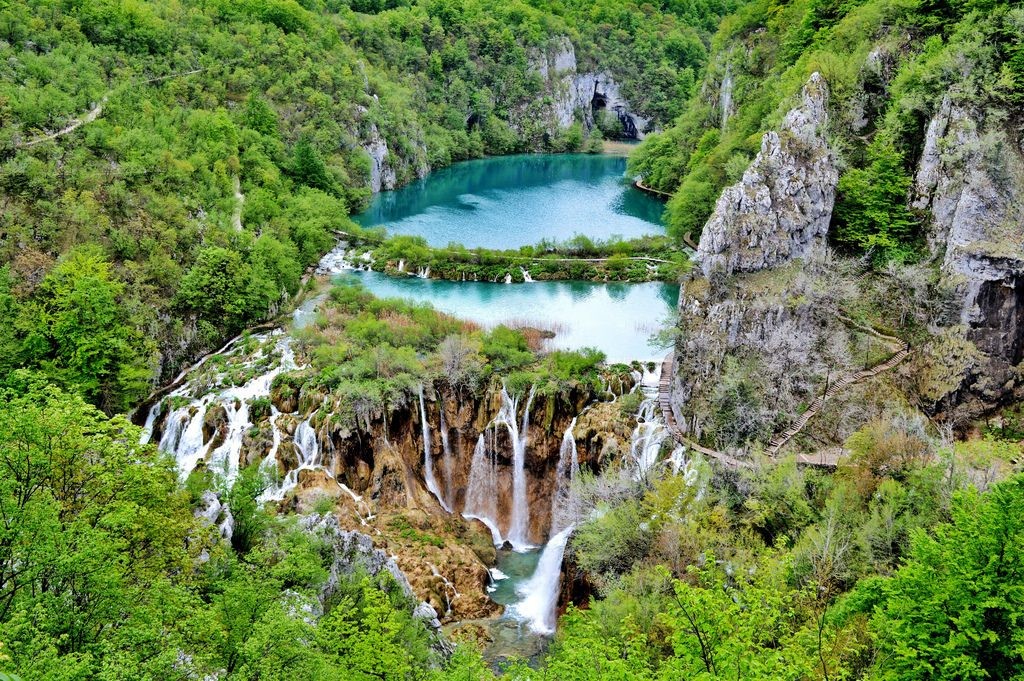 |
| Photo: Roselinde |
Plitvice Lakes National Park – A fairytale land of rare animals and flowers
With regard to plant and animal diversity, the area of the Plitvice Lakes is one of the most significant areas of Croatia, due to climatic conditions and its relatively remote location, since the lakes are at a fair distance from polluted and noisy cities and industrial plants. As a result of the low level of industrial development in this region and the early introduction of protective measures, a nearly untouched landscape has been preserved. In the partially primeval beech and fir forests various rare species, such as the brown bear have survived.
The Plitvice Lakes national park is heavily forested, mainly with beech, spruce, and fir trees, and features a mixture of Alpine and Mediterranean vegetation. It has a notably wide variety of plant communities, due to its range of microclimates, differing soils, and varying levels of altitude.
Scientists have so far identified 1,267 different types of plants belonging to the 109 species so far recorded in the area of the national park. 75 species of plants are endemic, which means that they were first defined and classified in this area of the world or nearby. A great number of these plants and species are protected by law. Within the national park area, 55 different species of orchids can be found.
The area of the national park is home to an extremely wide variety of animal and bird species. Rare fauna such as the European brown bear, grey wolf, eagle, owl, Eurasian lynx, European wildcat, and capercaillie can be found there, along with many more common species.
The wider area of the national park is one of the last areas in Europe in which a great number of wild brown bears and wolves can be found. The rich fauna of the Plitvice Lakes includes some 50 species of mammals. Scientists have so far discovered 321 different kinds of butterflies, of which 76 are day-flying butterflies, and 245 are nocturnal moths.
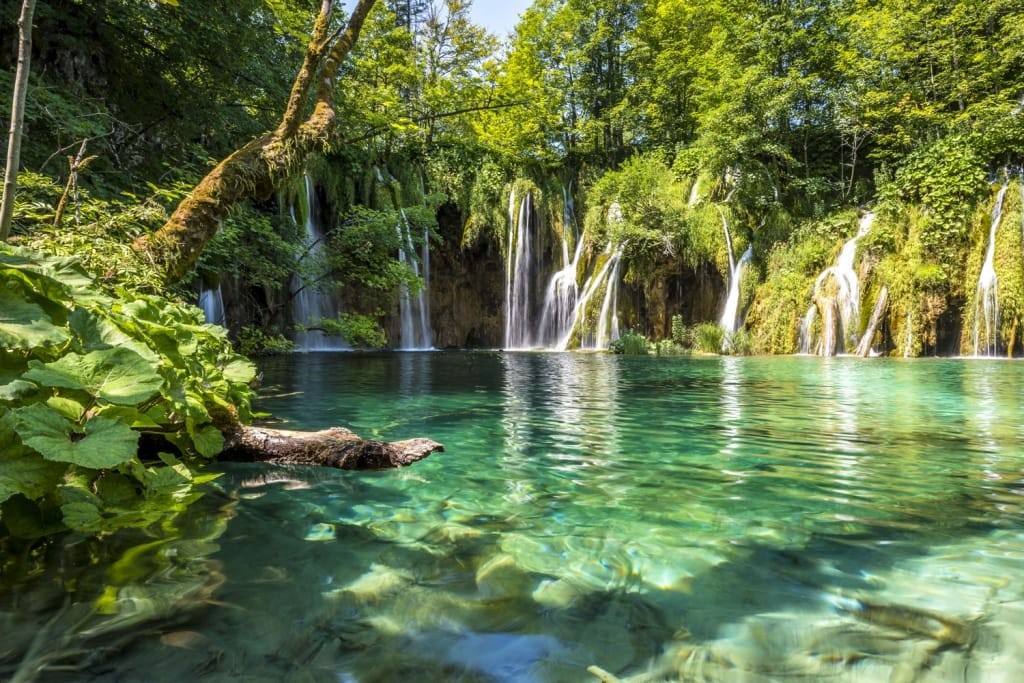 |
| Photo: Road Affair |
As regards bird species, the Plitvice Lakes rank third among the Croatian national parks for diversity. Some 157 species have been counted, of which 70 have been recorded as breeding there. The Plitvice Lakes are also home to many kinds of bats. Recent findings list about 20 different kinds of bat species, among them the rare species of Plecotus.
The great plant diversity creates a fascinating interplay of colors that change with the seasons. The lake area is surrounded by dense forests. The national park has an area of 29,842 hectares, of which some 22,308 hectares are forests (74.75 percent), 6,957 ha are meadows (23.31 percent) in village areas and 217 ha (0.72 percent) are water areas. A unique area is the forest of Čorkova uvala, a 79.50 ha large virgin forest in the northwestern part of the park. The beech and fir trees in this area of the park are up to 700 years old.
The best time to visit in the year
Plitvice Lakes isn’t just for summer. It’s a stunning place to visit any time of year as the different seasons see the Park take on different hues, whether that’s lush greenery in spring/summer, rich colors in autumn, or magical scenes in the snow and ice in winter. Even if conditions are rainy, the park can still be wonderful to explore as the water takes on a dramatic effect – sometimes bubbling up underneath your feet on the wooden pathways!
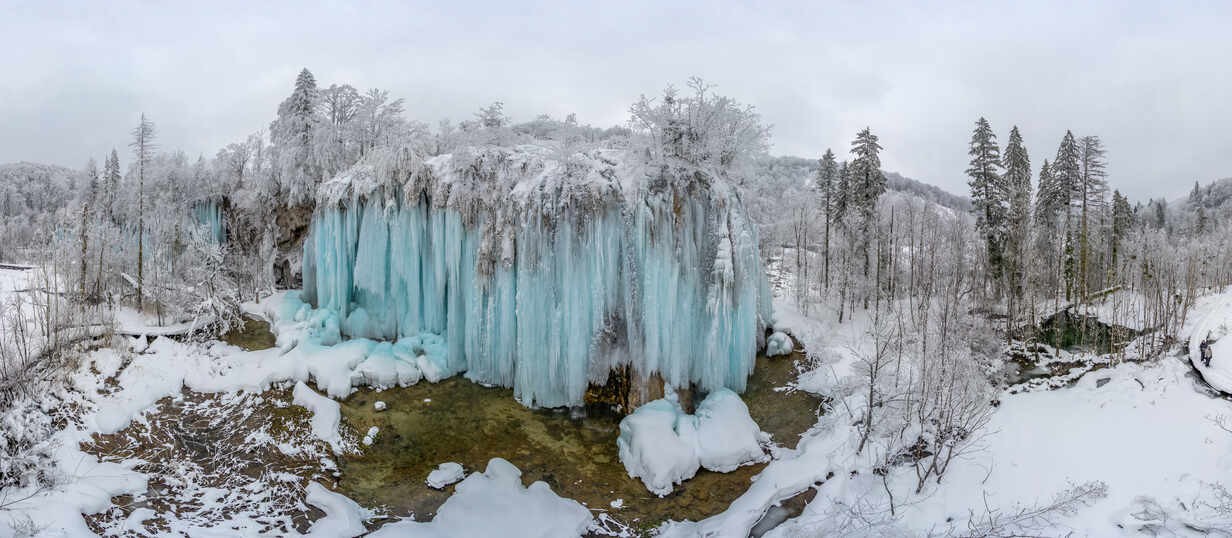 |
| Photo: Westend61 |
Accommodation in the Plitvice Lakes
It is possible to stay right next to the Park at one of its three hotels (which are all clustered quite closely together by Entrance 2) or at its campsite, Camp Korana (which contains bungalows or space for 500 camping units), which is about 7km from entrance 1. Another campsite, Camp Borje, is 15km away from Entrance 2. Another hotel, the Hotel Grabovac, that is also located 12km north of the Park.
There is also a very wide selection of private accommodation (rooms, apartments in guesthouses and similar) in the region. These include some options very close to the park entrances, but also plenty of choice in a number of the towns and villages (such as Slunj) on the way to the Park. If you don’t have your own car, make sure you pick an accommodation choice that’s within walking distance to the Park!

